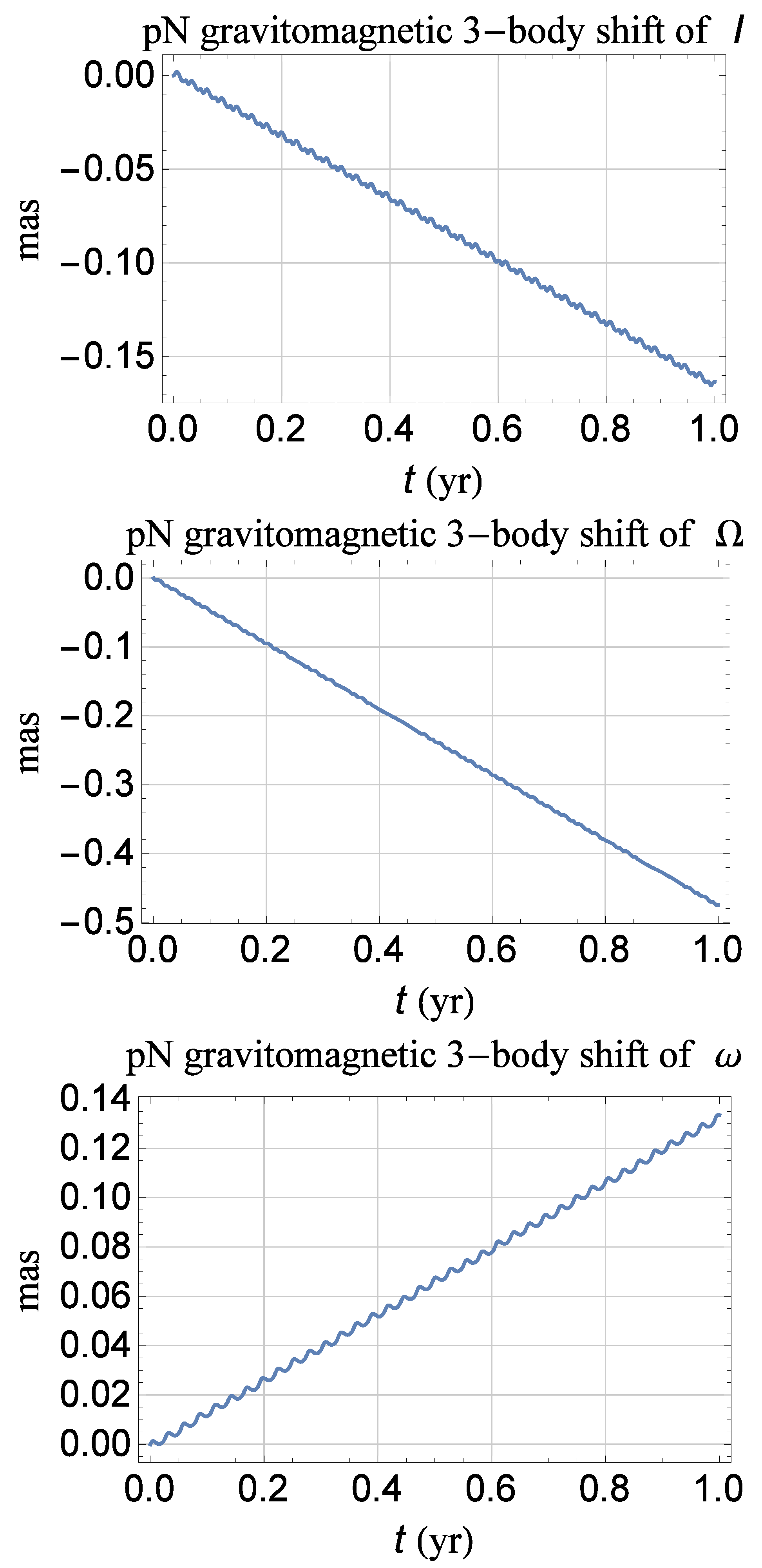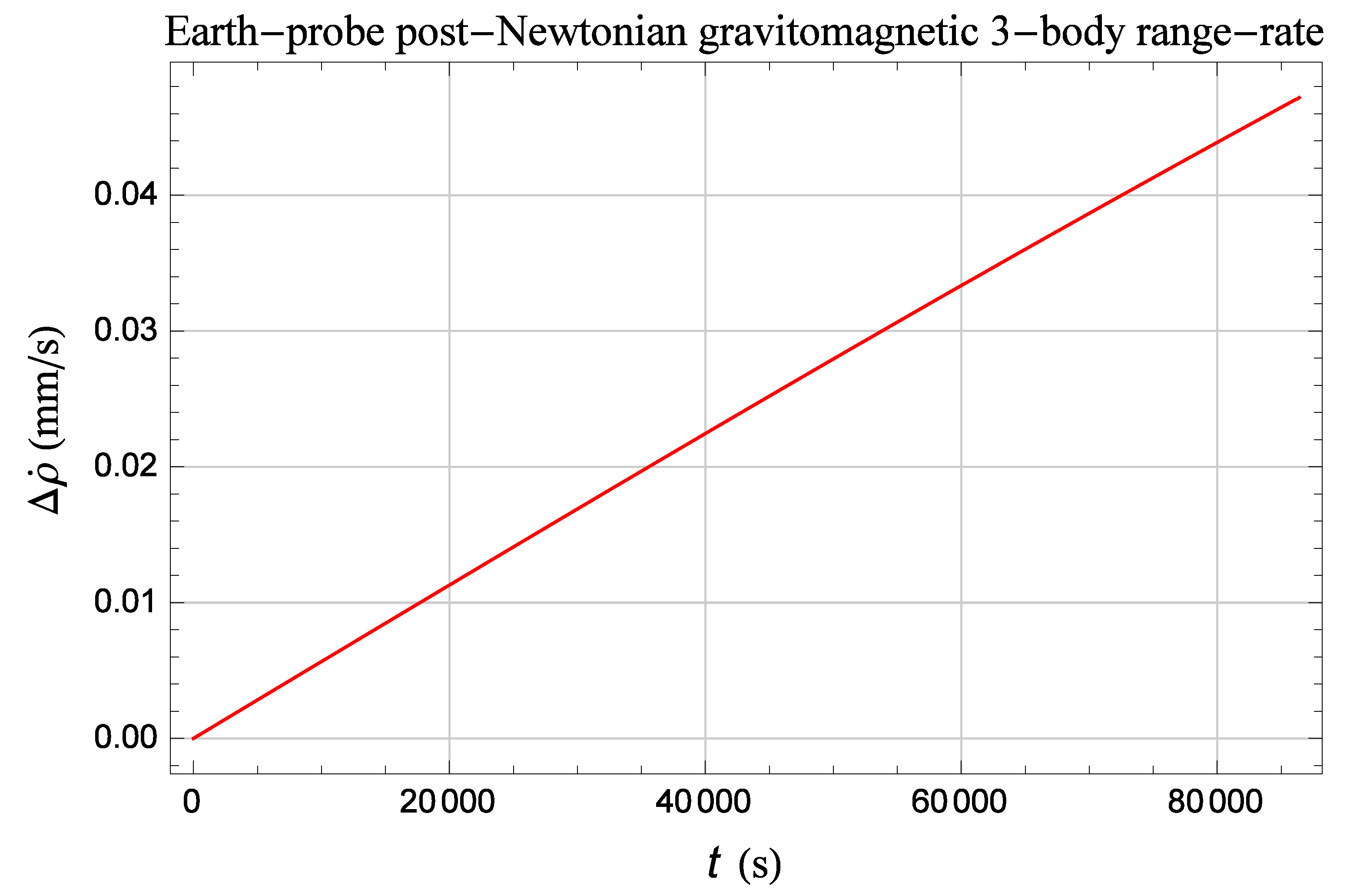A Post-Newtonian Gravitomagnetic Effect on the Orbital Motion of a Test Particle around Its Primary Induced by the Spin of a Distant Third Body
Abstract
:1. Introduction
2. The Doubly Averaged Satellite’s Orbital Precessions
3. Some Potentially Interesting Astronomical Scenarios
4. Summary and Overview
Acknowledgments
Conflicts of Interest
Appendix A. Notations and Definitions
- Newtonian constant of gravitation
- speed of light in vacuum
- mean obliquity
- mass of the distant 3rd body X (a star like the Sun or a planet like, e.g., Jupiter or Saturn)
- gravitational parameter of the 3rd body X
- equatorial radius of the 3rd body X
- magnitude of the angular momentum of the 3rd body X
- normalized moment of inertia of the 3rd body X
- angular speed of the 3rd body X
- spin axis of the 3rd body X in some coordinate system
- right ascension (RA) of the 3rd body’s spin axis
- declination (DEC) of the 3rd body’s spin axis
- component of the 3rd body’s spin axis w.r.t. the reference x axis of an equatorial coordinate system
- component of the 3rd body’s spin axis w.r.t. the reference y axis of an equatorial coordinate system
- component of the 3rd body’s spin axis w.r.t. the reference z axis of an equatorial coordinate system
- position vector towards the 3rd body X
- distance of to the 3rd body X
- versor of the position vector towards the 3rd body X
- semimajor axis of the orbit about the 3rd body X
- mean motion of the orbit about the 3rd body X
- orbital period of the orbit about the 3rd body X
- eccentricity of the orbit about the 3rd body X
- inclination of the orbital plane of orbit about the 3rd body X to the reference plane of some coordinate system
- longitude of the ascending node of the orbit about the 3rd body X referred to the reference plane of some coordinate system
- mass of the primary (planet or planetary natural satellite) orbited by the test particle and moving in the external field of the 3rd body X
- gravitational parameter of the primary orbited by the test particle and moving in the external field of the 3rd body X
- radius of the primary (planet or planetary natural satellite) orbited by the test particle and moving in the external field of the 3rd body X
- angular momentum of the primary
- position vector of the test particle with respect to its primary
- magnitude of the position vector of the test particle
- velocity vector of the test particle
- orbital angular momentum per unit mass of the test particle
- semimajor axis of the test particle’s orbit
- Keplerian mean motion of the test particle’s orbit
- orbital period of the test particle’s orbit
- eccentricity of the test particle’s orbit
- true anomaly of the test particle’s orbit
- inclination of the orbital plane of the test particle’s orbit to the reference plane of some coordinate system
- longitude of the ascending node of the test particle’s orbit referred to the reference plane of some coordinate system
Appendix B. Tables
| Parameter | Units | Numerical Value |
|---|---|---|
| G | ||
| c | ||
| − | ||
| d | ||
| − | ||
| d |
| Parameter | Units | Numerical Value |
|---|---|---|
| G | ||
| c | ||
| − | ||
| yr | ||
| − | ||
| yr |
References
- Frutos-Alfaro, F.; Soffel, M. On relativistic multipole moments of stationary space-times. R. Soc. Open Sci. 2018, 5, 180640. [Google Scholar] [CrossRef] [PubMed]
- Soffel, M.; Frutos, F. On the Usefulness of Relativistic Space-Times for the Description of the Earth’s Gravitational Field. J. Geod. 2016, 90, 1345–1357. [Google Scholar] [CrossRef]
- Capderou, M. Satellites: Orbits and Missions; Springer: Berlin, Germany, 2005. [Google Scholar]
- Poisson, E.; Will, C.M. Gravity; Cambridge University Press: Cambridge, UK, 2014. [Google Scholar]
- Angélil, R.; Saha, P.; Bondarescu, R.; Jetzer, P.; Schärer, A.; Lundgren, A. Spacecraft clocks and relativity: Prospects for future satellite missions. Phys. Rev. D 2014, 89, 064067. [Google Scholar] [CrossRef]
- Schanner, M.; Soffel, M. Relativistic satellite orbits: Central body with higher zonal harmonics. Celest. Mech. Dyn. Astr. 2018, 130, 40. [Google Scholar] [CrossRef]
- Schärer, A.; Bondarescu, R.; Saha, P.; Angélil, R.; Helled, R.; Jetzer, P. Prospects for Measuring Planetary Spin and Frame-Dragging in Spacecraft Timing Signals. Front. Astron. Space Sci. 2017, 4, 11. [Google Scholar] [CrossRef]
- Brumberg, V.A.; Kopeikin, S.M. Relativistic reference systems and motion of test bodies in the vicinity of the Earth. Nuovo Cimento B 1989, 103, 63–98. [Google Scholar] [CrossRef]
- Damour, T.; Soffel, M.; Xu, C. General-relativistic celestial mechanics. IV. Theory of satellite motion. Phys. Rev. D 1994, 49, 618. [Google Scholar] [CrossRef]
- Kopeikin, S.; Efroimsky, M.; Kaplan, G. Relativistic Celestial Mechanics of the Solar System; Wiley-VCH: Weinheim, Germany, 2011. [Google Scholar]
- de Sitter, W. Einstein’s theory of gravitation and its astronomical consequences, Second Paper. Mon. Not. R. Astron. Soc. 1916, 77, 155–184. [Google Scholar] [CrossRef]
- Fokker, A.D. De geodetische precessie; een uitvloeisel van Einstein’s gravitatie- theorie. Versl. Kon. Ak. Wet. 1920, 29, 611–621. [Google Scholar]
- Schouten, W.J.A. Over het ontstaan eener praecessiebeweging tengevolge van het niet euklidisch zijn der ruimte in de nabijheiud van zon. Versl. Kon. Ak. Wet. 1918, 27, 214. [Google Scholar]
- Gill, E.; Soffel, M.; Ruder, H.; Schneider, M. Relativistic Motion of Gyroscopes and Space Gradiometry; Deutsche Geodätische Kommission: München, Germany, 1992. [Google Scholar]
- Barker, B.M.; O’Connell, R.F. The gravitational interaction: Spin, rotation, and quantum effects-A review. Gen. Relat. Gravit. 1979, 11, 149–175. [Google Scholar] [CrossRef]
- Bertotti, B.; Farinella, P.; Vokrouhlický, D. Physics of the Solar System; Kluwer Academic Press: Dordrecht, The Netherlands, 2003. [Google Scholar]
- Efroimsky, M. Gauge freedom in orbital mechanics. Ann. N. Y. Acad. Sci. 2005, 1065, 346–374. [Google Scholar] [CrossRef]
- Iorio, L. Post-Newtonian direct and mixed orbital effects due to the oblateness of the central body. Int. J. Mod. Phys. D 2015, 24, 1550067. [Google Scholar] [CrossRef]
- Will, C.M. Incorporating post-Newtonian effects in N-body dynamics. Phys. Rev. D 2014, 89, 044043. [Google Scholar] [CrossRef]
- Hogg, D.W.; Quinlan, G.D.; Tremaine, S. Dynamical limits on dark mass in the outer solar system. Astron. J. 1991, 101, 2274–2286. [Google Scholar] [CrossRef]
- Lunine, J.I. Ocean worlds exploration. Acta Astronaut. 2017, 131, 123–130. [Google Scholar] [CrossRef]
- MacKenzie, S.M.; Caswell, T.E.; Phillips-Lander, C.M.; Stavros, E.N.; Hofgartner, J.D.; Sun, V.Z.; Powell, K.E.; Steuer, C.J.; O’Rourke, J.G.; Dhaliwal, J.K.; et al. THEO concept mission: Testing the habitability of Enceladus’s Ocean. Adv. Space Res. 2016, 58, 1117–1137. [Google Scholar] [CrossRef]
- Razzaghi, A.I.; di Pietro, D.A.; Quinn, D.A.; Simon-Miller, A.A.; Tompkins, S.D. Space Technology and Applications International Forum-STAIF 2008; American Institute of Physics Conference Series; El-Genk, M.S., Ed.; American Institute of Physics: College Park, MD, USA, 2008; Volume 969, pp. 388–395. [Google Scholar]
- Sherwood, B.; Lunine, J.; Sotin, C.; Cwik, T.; Naderi, F. Program options to explore ocean worlds. Acta Astronaut. 2018, 143, 285–296. [Google Scholar] [CrossRef]
- Spencer, J.; Niebur, C. Planetary Science Decadal Survey. Enceladus Orbiter; National Aeronautics and Space Administration: Washington, DC, USA, 2010.
- Verma, A.K.; Margot, J.-L. Expected precision of Europa Clipper gravity measurements. Icarus 2018, 314, 35–49. [Google Scholar] [CrossRef]
- Bolton, S.J.; Lunine, J.; Stevenson, D.; Connerney, J.E.P.; Levin, S.; Owen, T.C.; Bagenal, F.; Gautier, D.; Ingersoll, A.P.; Orton, G.S.; et al. The Juno mission. Space Sci. Rev. 2017, 213, 5–37. [Google Scholar] [CrossRef]
- Iess, L.; Folkner, W.M.; Durante, D.; Parisi, M.; Kaspi, Y.; Galanti, E.; Guillot, T.; Hubbard, W.B.; Stevenson, D.J.; Anderson, J.D.; et al. Measurement of Jupiter’s asymmetric gravity field. Nature 2018, 555, 220–222. [Google Scholar] [CrossRef]
- Petit, G.; Luzum, B. IERS Conventions. IERS Tech. Note 2010, 36, 1. [Google Scholar]
- Seidelmann, P.K.; Archinal, B.A.; A’hearn, M.F.; Conrad, A.; Consolmagno, G.J.; Hestroffer, D.; Hilton, J.L.; Krasinsky, G.A.; Neumann, G.; Oberst, J.; et al. Report of the IAU/IAG Working Group on cartographic coordinates and rotational elements: 2006. Celest. Mech. Dyn. Astr. 2007, 98, 155–180. [Google Scholar] [CrossRef]
- Soffel, M.; Klioner, S.A.; Petit, G.; Wolf, P.; Kopeikin, S.M.; Bretagnon, P.; Brumberg, V.A.; Capitaine, N.; Damour, T.; Fukushima, T.; et al. The IAU 2000 resolutions for astrometry, celestial mechanics, and metrology in the relativistic framework: Explanatory supplement. Astron. J. 2003, 126, 2687. [Google Scholar] [CrossRef]


© 2019 by the author. Licensee MDPI, Basel, Switzerland. This article is an open access article distributed under the terms and conditions of the Creative Commons Attribution (CC BY) license (http://creativecommons.org/licenses/by/4.0/).
Share and Cite
Iorio, L. A Post-Newtonian Gravitomagnetic Effect on the Orbital Motion of a Test Particle around Its Primary Induced by the Spin of a Distant Third Body. Universe 2019, 5, 87. https://doi.org/10.3390/universe5040087
Iorio L. A Post-Newtonian Gravitomagnetic Effect on the Orbital Motion of a Test Particle around Its Primary Induced by the Spin of a Distant Third Body. Universe. 2019; 5(4):87. https://doi.org/10.3390/universe5040087
Chicago/Turabian StyleIorio, Lorenzo. 2019. "A Post-Newtonian Gravitomagnetic Effect on the Orbital Motion of a Test Particle around Its Primary Induced by the Spin of a Distant Third Body" Universe 5, no. 4: 87. https://doi.org/10.3390/universe5040087
APA StyleIorio, L. (2019). A Post-Newtonian Gravitomagnetic Effect on the Orbital Motion of a Test Particle around Its Primary Induced by the Spin of a Distant Third Body. Universe, 5(4), 87. https://doi.org/10.3390/universe5040087





